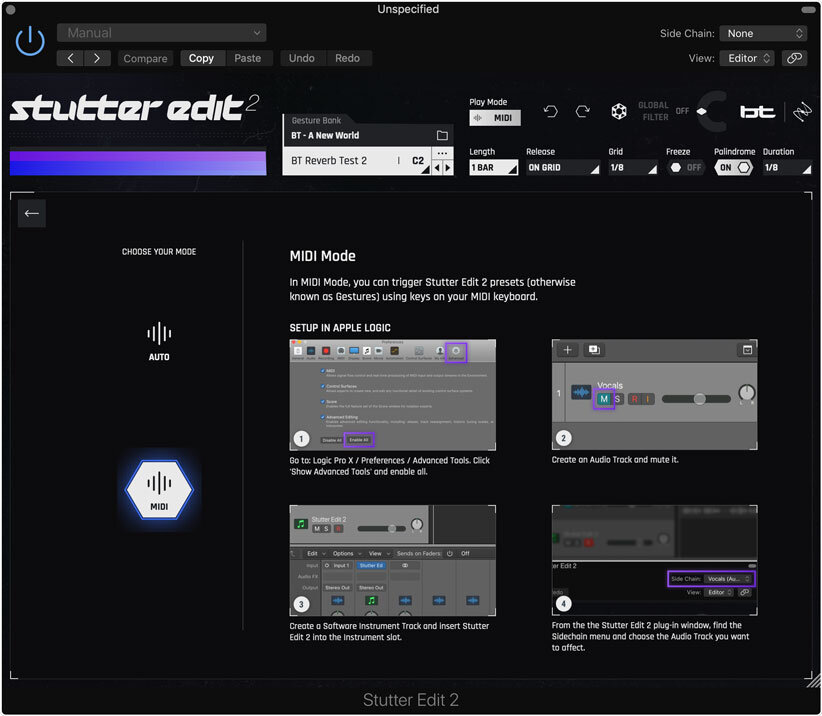

- #How to use izotope stutter edit in ableton software#
- #How to use izotope stutter edit in ableton professional#
- #How to use izotope stutter edit in ableton series#
It’s worth noting that iZotope present RX as software that can find application across all kinds of audio work. More complex problem sounds have more complex repair modes, but with a little experience, they are barely any more difficult to implement.Ī rogue click is clearly visible in RX4’s spectral display. Each of these issues took just a few seconds to eliminate entirely in RX4: lasso the problem area, press ‘R’ for repair, and the offending item is attenuated to inaudibility. The pictures show how these look in the RX4 main display: the click is shown in Linear mode, as digital clicks have content across the whole frequency spectrum, while the vocal pop is shown in Extended Log mode because plosives have a great deal of low–end content. In my mastering suite, with its revealing acoustics and speakers with extended bass response, I often encounter vocal plosives and very fast transient clicks that have been missed by the client and the engineer. And that was only the Spectral Repair feature, which provides a highly informative visual interface for spotting and addressing these problems. Even with projects that did not call for large–scale restoration work, it was good to be able to identify such momentary irritations as vocal glitches, the base of a mic stand being kicked, the studio cat, mic capsule distortions, clunks, coughs and so on, and quickly brush them aside. It has exceedingly good sample–rate conversion (with MBit+ dithering) and, of course, it can repair sonic damage, ameliorating those bad–luck moments in live recordings and unnoticed horrors in studio recordings which cannot be recalled and undone. RX can play almost any file, and has frequently opened recalcitrant formats which had standard DAWs flummoxed. Apart from the DAW itself, it is the one piece of software that I have found to be indispensable, and I have used it on pretty much every mastering session. I have now been using iZotope RX2 since it was released in 2010.

Only after those projects were completed did I begin to realise how tightly woven into my mastering approach it would become.
#How to use izotope stutter edit in ableton professional#
Other offerings were beyond the budget, so RX2 fitted the bill perfectly, and I still think that the Advanced version is a whole lot of professional software solution for a relatively small outlay. Sod’s Law dictated that the job came in just after I’d sold my SADiE system, and the built–in Spectral Cleaning facility in Magix’s Sequoia could not do all that was needed.
#How to use izotope stutter edit in ableton series#
I originally bought iZotope RX2 to do some fairly heavy restoration work on a series of 1970s live operas that I was remastering for issue on DVD and accompanying CD. It was expensive, but invaluable: recording engineers’ nightmares such as piano pedal thumps, piano stool creaks, even lip smacks and the occasional cough no longer demanded a re–take, but could be eliminated, or substantially reduced, in post–production. Someone will tell me that the DeNoise module in Sonic Solutions was probably in the vanguard here, but my own first encounter with this class of tool was CEDAR Retouch, fitted as an optional extra in the SADiE system which we used to record, edit and master classical recordings a decade ago. Restoration software of a kind which is relatively easy to use and which gives decent results is a comparatively new sector of the music software market. The latest version of iZotope’s RX adds some interesting features - but do they have musical applications? As well as the usual noise-reduction algorithms, RX also includes clip reduction and an. Izotope are the latest developers to release a suite of tools for tackling problem audio.


 0 kommentar(er)
0 kommentar(er)
